Horringslegitdocuments
On this page, you find all documents, package deals, and flashcards offered by seller horringslegitdocuments.
- 29
- 0
- 0
Community
- Followers
- Following
29 items
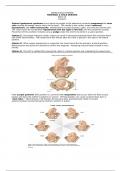
UWORLD NCLEX REVIEW MATERNAL & CHILD NURSING
Supine hypotensive syndrome occurs when the weight of the abdominal contents compresses the vena cava causing decreased venous return to the heart. This results in low cardiac output (maternal hypotension) and reflex tachycardia. Manifestations include dizziness, pallor, and cold and clammy skin. The client should be immediately repositioned onto the right or left side until the symptoms subside. Prevention of this condition includes using a wedge under the client's hip while in a supine ...
- Other
- • 84 pages •
Supine hypotensive syndrome occurs when the weight of the abdominal contents compresses the vena cava causing decreased venous return to the heart. This results in low cardiac output (maternal hypotension) and reflex tachycardia. Manifestations include dizziness, pallor, and cold and clammy skin. The client should be immediately repositioned onto the right or left side until the symptoms subside. Prevention of this condition includes using a wedge under the client's hip while in a supine ...
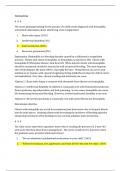
PEDDIATRIA
The nurse planning teaching for the parents of a child newly diagnosed with hemophilia will include information about which long-term complication? 1. Heart valve injury [33%] 2. Intellectual disability [3%] 3. Joint destruction [54%] 4. Recurrent pneumonia [8%
- Exam (elaborations)
- • 231 pages •
The nurse planning teaching for the parents of a child newly diagnosed with hemophilia will include information about which long-term complication? 1. Heart valve injury [33%] 2. Intellectual disability [3%] 3. Joint destruction [54%] 4. Recurrent pneumonia [8%

VATI Peds Remediation
A nurse is performing a developmental screening on a 4-month-old infant. Identify two (2) physical and motor skills the nurse should expect to see from the infant. Suggested Learning Activity: Developmental Stages and Transition i. Motor skills (4 mo.) 1. Rolls from back to side and grasps objects with both hands. ii. Physical skills (4 mo.) 1. Babinski reflex and plantar grasp
- Exam (elaborations)
- • 4 pages •
A nurse is performing a developmental screening on a 4-month-old infant. Identify two (2) physical and motor skills the nurse should expect to see from the infant. Suggested Learning Activity: Developmental Stages and Transition i. Motor skills (4 mo.) 1. Rolls from back to side and grasps objects with both hands. ii. Physical skills (4 mo.) 1. Babinski reflex and plantar grasp
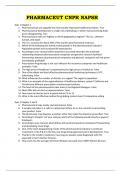
PHARMACEUT CNPR NAPSR
Pharmaceutical development is a high-risk undertaking, in which many promising leads prove disappointing. True 3. Pharmaceutical sales are highest in which geographical regions? The U.S., Western Europe, and Japan 4. The U.S. accounts for about 50% of the world’s pharmaceutical revenues. 5. Which of the following has fueled recent growth in the pharmaceutical industry? Population growth and increased life expectancies
- Exam (elaborations)
- • 18 pages •
Pharmaceutical development is a high-risk undertaking, in which many promising leads prove disappointing. True 3. Pharmaceutical sales are highest in which geographical regions? The U.S., Western Europe, and Japan 4. The U.S. accounts for about 50% of the world’s pharmaceutical revenues. 5. Which of the following has fueled recent growth in the pharmaceutical industry? Population growth and increased life expectancies
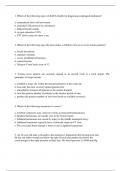
ATLS Post Test
Which of the following signs the necessitates a definitive airway in severe trauma patients? a. fascial lacerations b. repeated vomiting c. severe maxillofacial fractures d. sternal fracture e. Glasgow Coma Scale score of 12
- Exam (elaborations)
- • 11 pages •
Which of the following signs the necessitates a definitive airway in severe trauma patients? a. fascial lacerations b. repeated vomiting c. severe maxillofacial fractures d. sternal fracture e. Glasgow Coma Scale score of 12
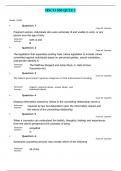
HSCO 500 QUIZ 1
Question 1 3 out of 3 points Pregnant women, individuals who were extremely ill and unable to work, or any person over the age of sixty Selected Answer: both A and B
- Exam (elaborations)
- • 7 pages •
Question 1 3 out of 3 points Pregnant women, individuals who were extremely ill and unable to work, or any person over the age of sixty Selected Answer: both A and B
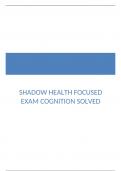
Shadow Health Focused Exam COUGH Danny Rivera with complete solutions rated A+
How long have you had a cough? • Finding: Asked about characteristics of cough • Finding: Reports cough is wet (Available) Pro Tip: The characteristics of a cough, such as whether it is dry or wet, can indicate key information about the type of illness the patient has. Example Question: Is your cough a wet cough? • Finding:
- Summary
- • 39 pages •
How long have you had a cough? • Finding: Asked about characteristics of cough • Finding: Reports cough is wet (Available) Pro Tip: The characteristics of a cough, such as whether it is dry or wet, can indicate key information about the type of illness the patient has. Example Question: Is your cough a wet cough? • Finding:
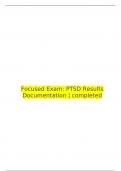
SHADOW HEALTH FOCUSED EXAM COGNITION SOLVED
Ms. Park is a 78-year-old Korean American woman with a history of HTN. She presented to the ER with a headache and inability to recall recent information. Ms. Park states the pain is a throbbing, pounding sensation in the front of her head that has increased since yesterday. She states the pain is an uncomfortable pressure that hurts worse when lying flat. She tried ginseng and cold compresses at home with no relief. She reports difficulty concentrating with a 9/10 pain in the ER. Ms. Park repor...
- Summary
- • 12 pages •
Ms. Park is a 78-year-old Korean American woman with a history of HTN. She presented to the ER with a headache and inability to recall recent information. Ms. Park states the pain is a throbbing, pounding sensation in the front of her head that has increased since yesterday. She states the pain is an uncomfortable pressure that hurts worse when lying flat. She tried ginseng and cold compresses at home with no relief. She reports difficulty concentrating with a 9/10 pain in the ER. Ms. Park repor...
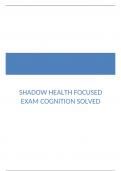
SHADOW HEALTH FOCUSED EXAM COGNITION SOLVED
Ms. Park is a 78-year-old Korean American woman with a history of HTN. She presented to the ER with a headache and inability to recall recent information. Ms. Park states the pain is a throbbing, pounding sensation in the front of her head that has increased since yesterday. She states the pain is an uncomfortable pressure that hurts worse when lying flat. She tried ginseng and cold compresses at home with no relief. She reports difficulty concentrating with a 9/10 pain in the ER. Ms. Park repor...
- Summary
- • 39 pages •
Ms. Park is a 78-year-old Korean American woman with a history of HTN. She presented to the ER with a headache and inability to recall recent information. Ms. Park states the pain is a throbbing, pounding sensation in the front of her head that has increased since yesterday. She states the pain is an uncomfortable pressure that hurts worse when lying flat. She tried ginseng and cold compresses at home with no relief. She reports difficulty concentrating with a 9/10 pain in the ER. Ms. Park repor...

Gizmo Lab: Earthquake - Recording Stations - Honors
Introduction: An earthquake releases an enormous amount of energy, which passes through Earth’s interior in the form of body waves. There are two types of body waves: P-waves (primary waves) and S-waves (secondary waves). Scientists study earthquakes with the aid of an instrument called a seismograph. When seismic waves reach the seismograph, a graphical record, or seismogram, is produced. Question: How are P- and S-waves shown on a seismogram
- Summary
- • 5 pages •
Introduction: An earthquake releases an enormous amount of energy, which passes through Earth’s interior in the form of body waves. There are two types of body waves: P-waves (primary waves) and S-waves (secondary waves). Scientists study earthquakes with the aid of an instrument called a seismograph. When seismic waves reach the seismograph, a graphical record, or seismogram, is produced. Question: How are P- and S-waves shown on a seismogram
